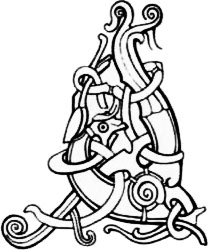 BEYOND THE GIRDLE of flint-grey water and the loveless lava flows, beyond the burning blue crevasses, lay Thrymheim, the storm-home of Skadi and her father Thiazi. It was a wonder that the hall withstood the charges of the wind and the batteries of hail.
BEYOND THE GIRDLE of flint-grey water and the loveless lava flows, beyond the burning blue crevasses, lay Thrymheim, the storm-home of Skadi and her father Thiazi. It was a wonder that the hall withstood the charges of the wind and the batteries of hail.
Tag: Odin
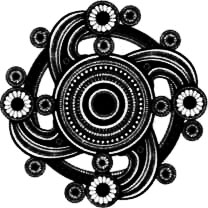 VERY EARLY ONE SUMMER MORNING, Odin, Loki and Honir crossed into Midgard, happy in one another’s company, and in- tent upon exploring some part of the earth not already known to them.
VERY EARLY ONE SUMMER MORNING, Odin, Loki and Honir crossed into Midgard, happy in one another’s company, and in- tent upon exploring some part of the earth not already known to them.
In the pale blue, almost pale green light that gives an edge to everything, the three friends crossed a desolate reach of grit, patrolled only by the winds. Before men in Midgard had stirred and woken, the gods were striding over scrubby, undulating ground. Then they tramped round a great mass of spiky, dead, dark rock, and headed for the summit of a conical mountain.
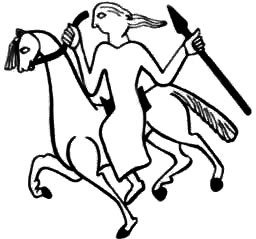 THE MOTHER OF SLEIPNIR was also the father of three appalling children. Not content with his faithful wife Sigyn, Loki sometimes took off for Jotunheim; the long-legged god hurried east and spent days and nights on end with the giantess Angrboda.
THE MOTHER OF SLEIPNIR was also the father of three appalling children. Not content with his faithful wife Sigyn, Loki sometimes took off for Jotunheim; the long-legged god hurried east and spent days and nights on end with the giantess Angrboda.
Loki and Angrboda had three monstrous offspring. The eldest was the wolf Fenrir; the second was Jormungand, greatest of serpents; and the third was a daughter called Hel. Even in a crowd of a thousand women, Hel’s looks were quite likely to single her out : her face and neck and shoulders and breasts and arms and back, they were all pink; but from her hips down, every inch of Hers skin looked decayed and greenish-black.
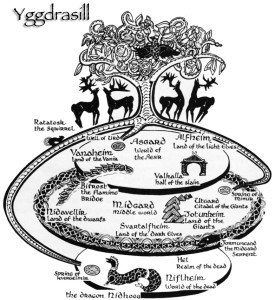 The Axis of the world was Yggdrasill. That ash soared and its branches fanned over gods and men and giants and dwarfs. It sheltered all creation. One root dug deep into Niflheim and under that root the spring Hvergelmir seethed and growled like water in a cauldron. Down there the dragon Nidhogg ripped apart corpses. Between mouthfuls, he sent the squirrel Ratatosk whisking up the trunk from deepest earth to heaven; it carried insults to the eagle who sat on the topmost bough, with a hawk perched on its brow. And Nidhogg was not content with corpses; he and his vile accomplices gnawed at the root of Yggdrasill itself, trying to loosen what was firm and put an end to the eternal.
The Axis of the world was Yggdrasill. That ash soared and its branches fanned over gods and men and giants and dwarfs. It sheltered all creation. One root dug deep into Niflheim and under that root the spring Hvergelmir seethed and growled like water in a cauldron. Down there the dragon Nidhogg ripped apart corpses. Between mouthfuls, he sent the squirrel Ratatosk whisking up the trunk from deepest earth to heaven; it carried insults to the eagle who sat on the topmost bough, with a hawk perched on its brow. And Nidhogg was not content with corpses; he and his vile accomplices gnawed at the root of Yggdrasill itself, trying to loosen what was firm and put an end to the eternal.
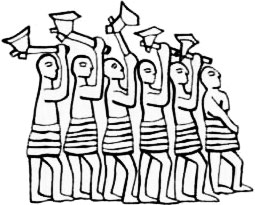 Long after the Golden Age, it was still very early in the cycle of time. And long after the war between the Aesir and the Vanir, the wall around Asgard that the Vanir had razed with their battle-magic remained a ring of rubble, deserted, the home of eagles and ravens.
Long after the Golden Age, it was still very early in the cycle of time. And long after the war between the Aesir and the Vanir, the wall around Asgard that the Vanir had razed with their battle-magic remained a ring of rubble, deserted, the home of eagles and ravens.
The gods were anxious that the wall should be rebuilt, so that Asgard would be safe from evil-doers, but none were eager to take the heavy burden of rebuilding on their own shoulders. This is how matters stood for some time until, one day, a solitary figure on horseback cantered over the trembling rainbow, and was stopped by the watchman Heimdall.
Odin did not extend a friendly welcome to the witch Gullveig when she came to visit him. In his hall the High One and many other Aesir listened with loathing as she talked of nothing but her love of gold, her lust of gold. They thought that the worlds would be better off without her and angrily seized and tortured her; they riddled her body with spears.
These tales have existed for thousands of years in the form of poems, songs and stories until put into written form in the early 11th century. Though several authors attempted to preserve them our “best” source is Snorri Sturluson’s Prose Edda. This is the creation story. This is the first of the 32+ Norse Myths. My main source is the “The Norse Myths” by Kevin Crossley-Holland.
According to Norse mythology, the beginning of life was fire and ice, with the existence of only two worlds: Muspelheim and Niflheim. When the warm air of Muspelheim hit the cold ice of Niflheim, the jötunn Ymir and the icy cow Audhumla were created. Ymir’s foot bred a son and a man and a woman emerged from his armpits, making Ymir the progenitor of the Jotun. Whilst Ymir slept, the intense heat from Muspelheim made him sweat, and he sweated out Surtr, a jötunn of fire. Later Ymir woke and drank Audhumbla’s milk. Whilst he drank, the cow Audhumbla licked on a salt stone. On the first day after this a man’s hair appeared on the stone, on the second day a head and on the third day an entire man emerged from the stone. His name was Búri and with an unknown jötunn female he fathered Bor, the father of the three gods Odin, Vili and Ve.
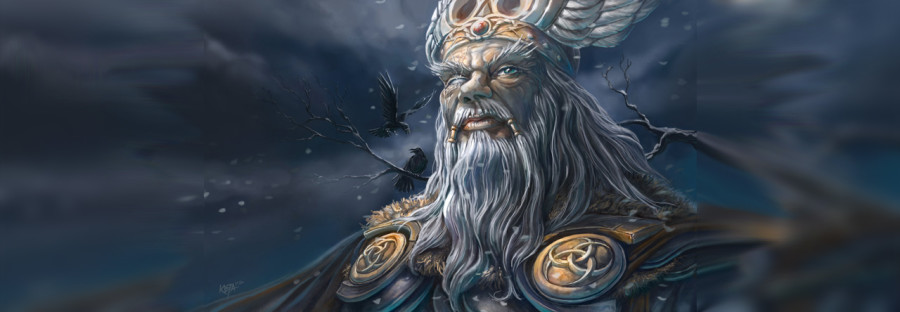
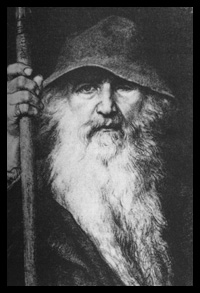 Odin or, depending upon the dialect Woden or Wotan, was the Father of all the Gods and men. Odin is pictured either wearing a winged helm or a floppy hat, and a blue-grey cloak. He can travel to any realm within the 9 Nordic worlds. His two ravens, Huginn and Munin (Thought and Memory) fly over the world daily and return to tell him everything that has happened in Midgard. He is a God of magick, wisdom, wit, and learning. In later times, he was associated with war and bloodshed from the Viking perspective, although in earlier times, no such association was present. If anything, the wars fought by Odin exist strictly upon the Mental plane of awareness; appropriate for that of such a mentally polarized God. He is both the shaper of Wyrd and the bender of Orlog; again, a task only possible through the power of Mental thought and impress. It is he who sacrifices an eye at the well of Mimir to gain inner wisdom, and later hangs himself upon the World Tree Yggdrasil to gain the knowledge and power of the Runes. All of his actions are related to knowledge, wisdom, and the dissemination of ideas and concepts to help Mankind.
Odin or, depending upon the dialect Woden or Wotan, was the Father of all the Gods and men. Odin is pictured either wearing a winged helm or a floppy hat, and a blue-grey cloak. He can travel to any realm within the 9 Nordic worlds. His two ravens, Huginn and Munin (Thought and Memory) fly over the world daily and return to tell him everything that has happened in Midgard. He is a God of magick, wisdom, wit, and learning. In later times, he was associated with war and bloodshed from the Viking perspective, although in earlier times, no such association was present. If anything, the wars fought by Odin exist strictly upon the Mental plane of awareness; appropriate for that of such a mentally polarized God. He is both the shaper of Wyrd and the bender of Orlog; again, a task only possible through the power of Mental thought and impress. It is he who sacrifices an eye at the well of Mimir to gain inner wisdom, and later hangs himself upon the World Tree Yggdrasil to gain the knowledge and power of the Runes. All of his actions are related to knowledge, wisdom, and the dissemination of ideas and concepts to help Mankind.
Odin can make the dead speak in order to question the wisest amongst them. His hall in Asgard is Valaskjalf (“shelf of the slain”) where his throne Hlidskjalf is located. From this throne he observes all that happens in the nine worlds. He also resides in Valhalla, where the slain warriors are taken.
Odin’s attributes are the spear Gungnir, which never misses its target, the ring Draupnir, from which every ninth night eight new rings appear, and his eight-footed steed Sleipnir. He is accompanied by the wolves Freki and Geri, to whom he gives his food for he himself consumes nothing but wine. Odin has only one eye, which blazes like the sun. His other eye he traded for a drink from the Well of Wisdom, and gained immense knowledge. On the day of the final battle, Odin will be killed by the wolf Fenrir.
Just as a point of curiosity: in no other pantheon is the head Deity also the God of Thought and Logic. It’s interesting to note that the Norse people set such a great importance upon logic. The day Wednesday (Wodensdaeg) is named for him.
